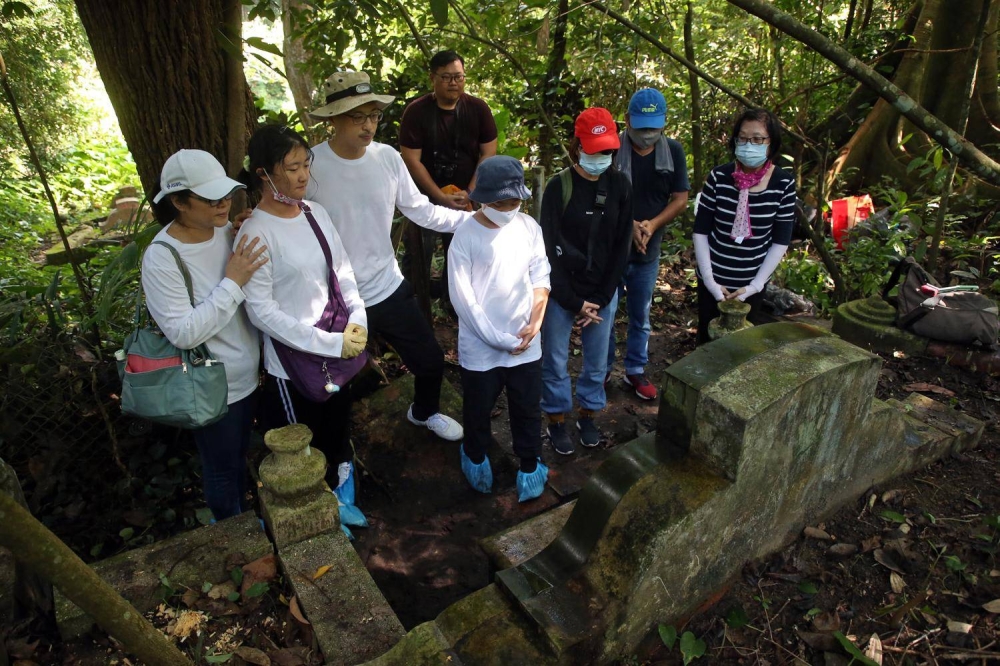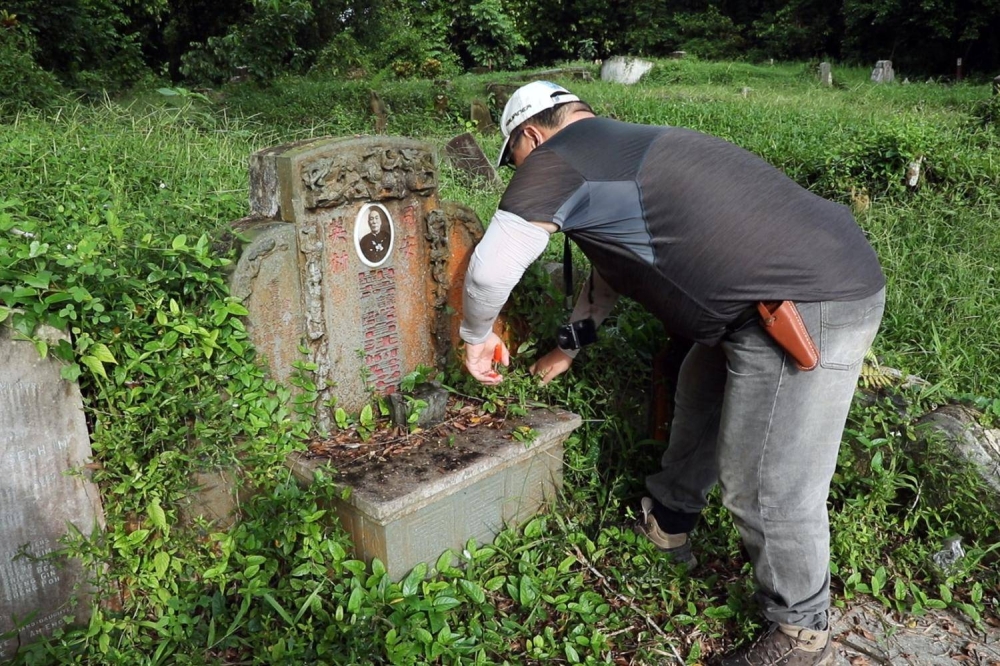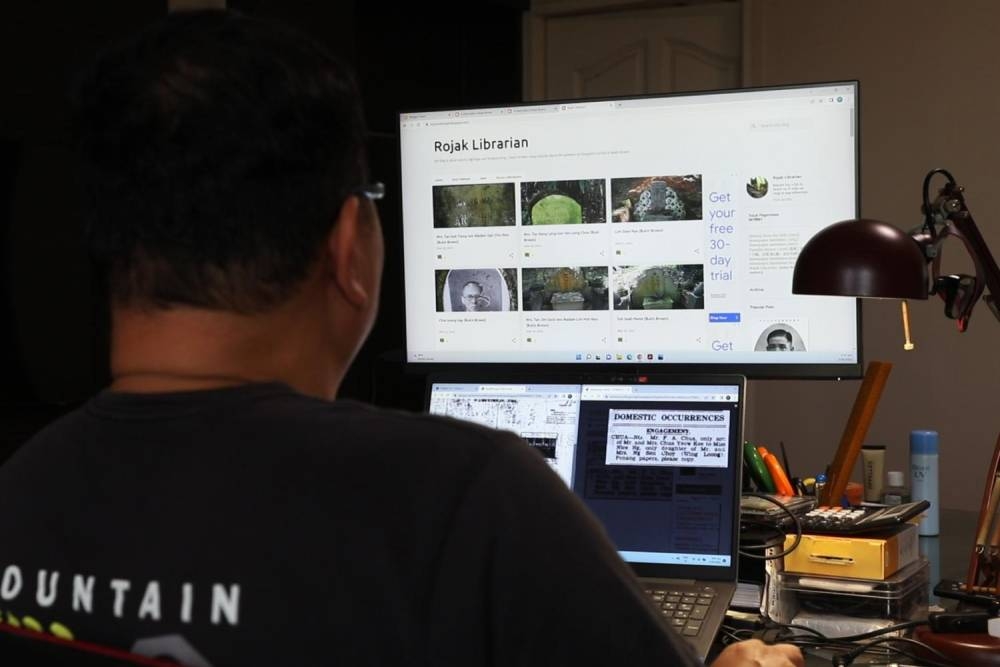SINGAPORE, Sept 5 — I whispered multiple sorrys under my breath as I stepped over graves strewn across overgrown grass.
It was a day after the Hungry Ghost Festival, but I would still rather not risk disturbing the dead as I stood in the middle of a cemetery on a bright, Saturday morning.
I was there at the invitation of self-professed grave hunter Peter Pak, who was helping a family of five locate their ancestors’ graves in Bukit Brown Cemetery.
Accompanying him was his crew — 58-year-old pharmacist Raymond Goh, 41-year-old Xu Mei Bao, a planner at an oil and gas company, and tomb keeper Soh Ah Beng, who declined to reveal his age.
The cemetery is a familiar place to Mr Pak, who is there almost every weekend to look for graves.
He led us to our first stop — a thicket just a little way up the main path of the cemetery.
“There, look under the bushes,” he said while pointing.
Nestled behind the overgrown shrubs was the resting place of the youngest family member’s great-great-great-grandmother.
Mr Pak and his crew began to snip away at the overgrown bushes with shears that they had carried along with them.
Slowly but surely, the name and death date of the deceased (1929) was revealed.
The family of five was visibly overjoyed, and they whipped out some incense sticks to say a collective prayer for their ancestor.
They were the fifth family that Mr Pak, a 49-year-old IT project manager at the National Library Board, has helped to reunite with their ancestors.
Tech-savvy descendants who came across his heritage blog, The Rojak Librarian, where he documents the graves that he discovers at Bukit Brown Cemetery, reached out to him for help in locating these tombs, said Mr Pak.
In the case of the family of five, a 35-year-old descendant had reached out to Mr Pak after coming across his blog.
From birds to tombs
Mr Pak’s visits to Bukit Brown Cemetery did not always involve documenting the dead.
An avid birdwatcher, Mr Pak first started visiting the cemetery in 2010 on birdwatching trips with the Nature Society (Singapore), posting pictures of birds on his blog.
It was only when the Government announced redevelopment plans for parts of the cemetery in 2011 that Mr Pak came to understand the historical significance of the cemetery.
Opened in 1922, the cemetery is the first public Chinese cemetery in colonial Singapore and is the resting place of prominent Singapore pioneers such as Ong Boon Tat, who opened Singapore’s first amusement park, and Lim Chong Pang, who has a housing estate named after him.
It closed in 1973 after the Government opened other public cemeteries in areas like Lim Chu Kang.
Mr Pak joined groups such as the Heritage Society and Nature Society (Singapore) to lobby the Government to reconsider its position to build a highway through the cemetery.
Although the Government eventually built Lornie Highway in 2018, Mr Pak continued to document other parts of Bukit Brown Cemetery alongside a group of about 20 other volunteers, dubbed The Brownies, to raise awareness about its heritage. Besides rediscovering old tombs, they also conduct public tours of the cemetery.
I could tell from our Saturday jaunt that years of public tours had not diminished Mr Pak’s childlike fascination for the cemetery.
As we walked among the tombs, he stopped frequently to point out wild bananas growing on trees, footprints of wild boars on the ground or share trivia about the cemetery.
“Did you know that there is a ‘pauper section’ in the cemetery where those without the means for a grave can bury their kin in free plots?” he told us, stopping in the middle of the pathway.
‘A bit like detective work’
Documenting tombstones around Bukit Brown Cemetery is “a little bit like detective work”, said Mr Pak, who trawls through the burial registers of the cemetery on the National Archives and cross-checks these names with references in old newspapers.
“Some of these names (on the tombs) are not unique. You must see if the name mentioned in (old newspapers) is the same as the person buried here. So you must make educated guesses along the way,” said Mr Pak.
For instance, if the departed’s death date is listed as 1930 but there are two newspaper articles — one in 1911 and one in 1933 — which mentions the name of the dead, then it is more likely that the person mentioned in the 1911 news article is the same as the person buried, explained Mr Pak.
While his blog was initially set up in 2011 to serve as a resource for tour guides at Bukit Brown Cemetery, Mr Pak said that its “by-product” has been to reconnect the deceased with their descendants.
“Somebody’s descendant who is savvy online will read the blog and realise that (the deceased) is their uncle or aunty,” said Mr Pak.
One such person was Mr Winston Teo, a 52-year-old engineer who had been trying to locate his grandfather’s grave for the last four decades.
And he had pretty much given up. None of his relatives could remember where his grandfather, Teo Geok Peck, was buried, only that it was somewhere in Kopi Sua (Coffee Hill) near Bukit Brown.
But in May this year, Mr Teo did a Google search for old pictures of his grandmother and discovered a blog post about his grandfather instead.
Not only did the post by Mr Pak have a picture of Mr Teo’s grandfather’s tomb, it also had information about his grandfather’s occupation and family tree.
“I was stunned. Why would someone write about my grandfather?” said Mr Teo, as he recalled his shock after discovering the blog.
With a little help from Mr Pak, Mr Teo was able to finally find his grandfather’s resting place on May 21.

‘Divine intervention’
Mr Pak, who is Catholic, attributed the reunions that he facilitates to “divine intervention”.
“I’m just an instrument. I write and write and somehow these people like Winston who are trying to find their ancestors... manage to connect with me,” he said.
That said, Mr Pak, who receives requests from people to find their ancestors’ graves “once every two to three months”, is not always able to reunite families, especially if he does not have the name and death date of the deceased.

Without this information, it is harder to locate the tomb based on the burial register from the National Archives, he said.
Most of the deceased whose tombs he documents also do not ever reconnect with their descendants, he added.
Supernatural encounters
When asked if he has ever had supernatural encounters during his grave hunts, he said: “I’ve not seen ghosts in Bukit Brown Cemetery yet, but there are instances where I am exploring and I felt that I wasn’t alone.
“It’s just a feeling, where no trees are moving.”
Mr Pak recalled an incident in November 2020 where he was helping to clear a tomb not too far away from Lornie Highway.
“And while cleaning, I suddenly realised that everything was very quiet all around. There were no bird calls and I couldn’t hear the sound of the cars from the highway. It was total silence.”
The noises suddenly came back after he stopped for a water break, said Mr Pak.
Mr Pak also believes there is a supernatural element involved in being able to connect the dead with their descendants.
“Although I have never encountered ghosts in that sense, I think there are spirits that guide us. If we do good things, things will also have a way of coming together.”
As I tailed him around on Saturday, I could also sense the deep respect that Mr Pak had for the dead.
At each tomb that we discovered, he would place his hand on the tomb after cleaning it and say: “It’s been a good day for you.”
Mr Pak has no intention to stop documenting graves at Bukit Brown for now, as he believes that what he is doing matters to people.
He said: “The main reason I do what I do is to make sure that this place (Bukit Brown Cemetery) is still very much connected to the living, to Singaporeans, so that they know where their ancestors are buried.”

By the end of Saturday morning, Mr Pak had helped the family locate three tombs of their ancestors at Bukit Brown Cemetery.
They shared with me that they were happy to have finally found the tombs of their ancestors, after failed attempts to do so before.
The trip had also sparked a lively discussion about their family’s heritage and history.
I understood then what Mr Pak had been trying to convey — that a cemetery should not be seen as a finality to life, but a way for the living to keep in touch with their loved ones. — TODAY






















